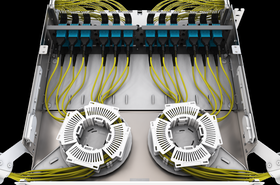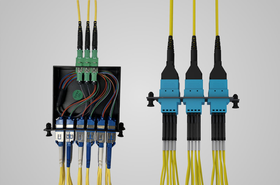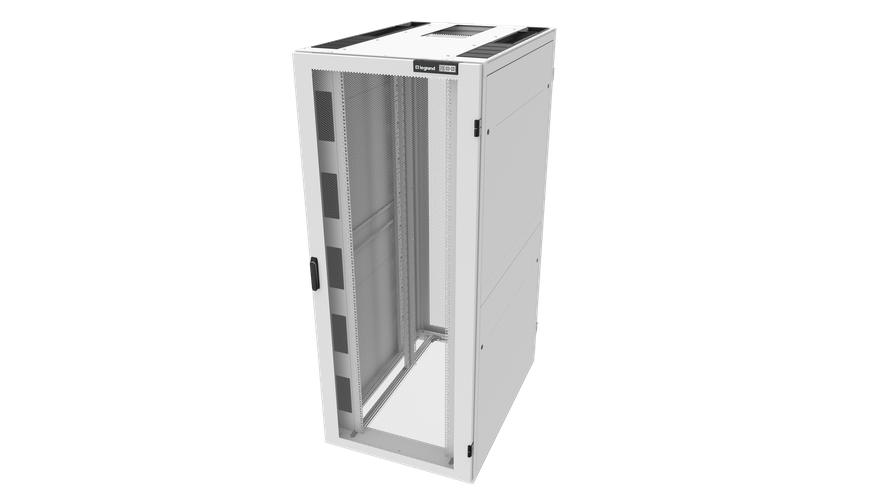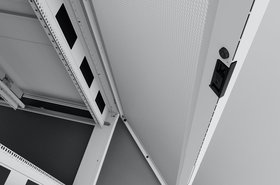Planning something as large and complex as a data center can be an onerous challenge in which many commissioning issues are left to be dealt with in detail later. But when it comes to cabinets, it makes sense to specify a platform that works not only in terms of the data center design on day one, but is flexible enough to support endless redesigns and layouts, not to mention operators’ drives towards net zero.
After all, a data center, like many other elements of critical infrastructure, isn’t static, but highly dynamic and regularly forced to respond to fast-changing technology developments and market demands, while maintaining the services customers and users have come to expect.
“The challenge for data center managers today is about making sure that they’re always up, uptime is critical. Today, especially with the increased density of data centers, it’s not always easy to manage the extra compute power including the thermal impact, and making sure that they’re connections are always available.” says Saman Berookhim, product manager of cabinets and containment at Legrand.
Furthermore, with construction costs rising – including land acquisition prices, materials, and labor costs – data center operators also have as strong an incentive to upgrade as they do to build new facilities. Therefore, it makes sense to specify cabinets that are as future-proofed, flexible, and sustainable as possible.
“There are going to be trade-offs for the foreseeable future between how data centers are upgraded and how they are built. I think the emphasis is going to be on how much more efficient existing data centers can be made if they’re upgraded,” adds Berookhim.
He cites the example of one major US colocation provider reaching capacity in one of its biggest installations on the East Coast. While a new build was attractive, current lead times and all the various costs associated with building from scratch encouraged the provider to look at upgrading its existing facilities instead.
And that wasn’t the only challenge. “They were maxed out on power utilization in the area. So they ended up investing in an upgrade of their facilities with new containment to help lower the energy utilization and increase their capacity footprint in the existing location,” says Berookhim.
With that idea in mind, the Nexpand Platform was designed to “do better” the next time the data center needs an upgrade.
High performance
In the past, data center server cabinets were something of an afterthought, while energy efficiency and sustainability were a lot further down the corporate list of priorities. But with cabinets housing the greater part of a data center’s energy consumption, the design and build quality of the cabinets has also become more important as sustainability has moved up the corporate agenda.
“At the time of the data center build, all parties involved work together to design a solution that works in the upcoming environment with the equipment that is going to be deployed within the cabinet.
“But I have heard too many times that, as new requirements are developed and the teams within the data center look to upgrade existing installations, there isn’t always a reliable way to achieve that. With a modular system, adding or removing components is simplified, thereby making it easier to make upgrades or handle unforeseen changes down the line,” says Berookhim.
Legrand developed the Nexpand Platform as a modular solution that can more easily accommodate data center upgrades and can also help operators improve their facilities’ efficiency by better handling the power and heat dissipation that modern server technology are designed to run at.
“Historically, cabinets did not consider the extreme pressures of efficiency that we see today,” says Berookhim. “All organizations in the data center space are looking to reduce their energy consumption and any energy usage must therefore be extremely efficient. This isn’t just something that affects the bottom line, especially at a time of rising power prices, but also affects the environment.
“Cabinets are at the epicenter of this energy usage since all the equipment operates within this footprint. That’s why having a cabinet that is efficient and adaptable for changing future environments is so critical.”
Legrand’s Nexpand cabinet is lightweight yet offers a 3,500 lbs (1,600kg) static load with aluminium extrusions as part of its highly flexible frame. As part of its modular design, air blockers seal spaces between cabinets and gaps, ensuring that the cabinet remains airtight.
Internally, it is designed to optimize airflow management, and when included, the airflow management package reduces bypass airflow and prevents recirculation. This package contains flexible, rail-mounted vertical panels with integrated cable management inside the rack and adjustable angles and seals to redirect airflow from below and between racks.
All these design flourishes are necessary to support the demands of modern server equipment, designed with greater heat tolerances in mind, enabling servers to be air-cooled as efficiently as possible. The quality of the cabinet is central to achieving this.
However, it’s all very well talking about sustainability, but what counts is ‘performing’ sustainability – especially with more and more organizations starting to consider their Scope 3 emissions, and everything that goes into the products they purchase from suppliers.
While Scope 1 covers direct corporate emissions, including from company vehicles, and Scope 2 encompasses purchased heat and power, Scope 3 covers all the harder to ascertain and measure environmental issues, including the sustainability of purchased goods and services.
“Cabinet manufacturers need to take on the responsibility to ensure that products meet environmental requirements,” says Berookhim, and data center operators looking to achieve net-zero carbon emissions any time in the next ten or twenty years will already need to be looking at their cabinet suppliers’ Scope 3 emissions if they’re to genuinely achieve their goals.
“The Nexpand Platform has a published product environment profile or PEP that is used to document the environmental impact and performance based on the life of the product. Not only do we calculate how much it impacts the environment today, but how long the product will be used for, and the long-term effects of each of the substances [used in its manufacture] will have,” he adds. This environmental profile goes into fine details even down to the chemicals used in the paint.
Getting hands on
These days, just getting hold of essential items of data center equipment can be as challenging as any part of a data center build or upgrade. If it isn’t lockdowns in manufacturing centers in China holding up important parts, its queues at major ports, too little warehouse space, a shortage of Over-the-Road drivers, or a lack of staff anywhere in the supply chain.
The hiatuses in global supply chains have also upended the just-in-time nature of data center cabinet supply, which would have affected a supplier like Legrand without its Nexpand factory.
However, Legrand has already headed that off before it comes to pass.
Traditionally, cabinets are manufactured using the just-in-time methodology. That means the supplier works back from the delivery date to ensure it has the components it needs just prior to manufacturing, which only starts when it can be completed in time for delivery. That minimizes the need for components to be stored before manufacturing.
“With Nexpand all the components are made in advance, so at the time of order only assembly of the product is required. The components that build the cabinets are produced in the volume necessary to keep the price of the cabinet in line with the market, but the cabinets are assembled at time of order, enabling quick deliveries,” says Berookhim.
Furthermore, Legrand has factories producing Nexpand worldwide, further reducing lead times and the risk of unexpected hold-ups.
“With facilities closer to many of our customers, they enjoy lower freight costs, lower transit times and less potential impact to their schedule should anything go awry in transit,” says Berookhim. After all, he adds, while many data center builders are playing it safe by over-ordering and ordering early, cabinets aren’t the easiest items to store for weeks or months.
Hence, with just-in-time delivery (without the uncertainty of just-in-time manufacturing), support for the needs of the most demanding data center servers available today, and a high-level of in-factory configurability in a robust and modular package, Nexpand is one detail that data center designers don’t need to fret about.
More from Legrand
-

Sponsored Legrand fiber solution connects Cisco Live 2022
Legrand provides connectivity for Cisco Live 2022 via its Infinium acclAIM fiber solution
-

Sponsored New demands, new solutions
Safety, flexibility, performance: The key to successful power distribution in an increasingly demanding data center environment
-

Sponsored Legrand announces the Infinium acclAIM™ fiber solution Is now available and ready to ship
Legrand’s Infiniium acclAIM fiber solution was honored in Lightwave’s 2022 Innovation Review


